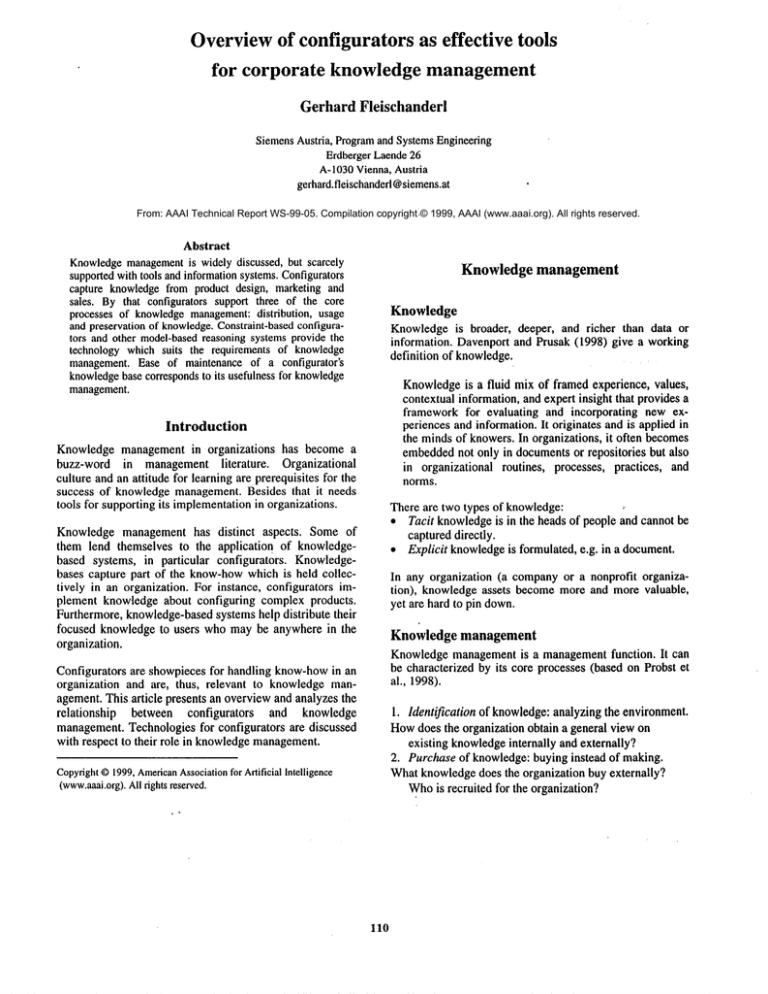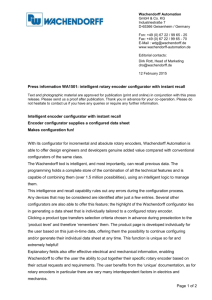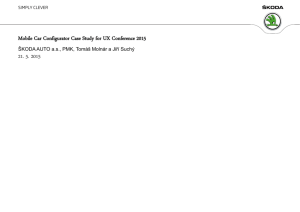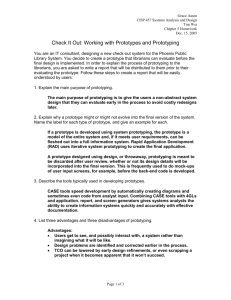
Overviewof configurators as effective tools
for corporate knowledge management
Gerhard Fleischanderl
SiemensAustria, Programand SystemsEngineering
ErdbergerLaende26
A-1030Vienna,Austria
gerhard.fleischanderl@siemens.at
From: AAAI Technical Report WS-99-05. Compilation copyright © 1999, AAAI (www.aaai.org). All rights reserved.
Abstract
Knowledge
management
is widely discussed, but scarcely
supportedwith tools and informationsystems.Configurators
capture knowledgefrom product design, marketing and
sales. By that configurators support three of the core
processes of knowledgemanagement:distribution, usage
and preservationof knowledge.Constraint-basedconfigurators and other model-based
reasoningsystems provide the
technology which suits the requirements of knowledge
management.Ease of maintenance of a configurator’s
knowledge
basecorrespondsto its usefulnessfor knowledge
management.
Knowledge
management
Knowledge
Knowledgeis broader, deeper, and richer than data or
information. Davenport and Prusak (1998) give a working
definition of knowledge.
Knowledgeis a fluid mix of framed experience, values,
contextual information, and expert insight that provides a
framework for evaluating and incorporating new experiences and information. It originates and is applied in
the mindsof knowers.In organizations, it often becomes
embeddednot only in documentsor repositories but also
in organizational routines, processes, practices, and
norms.
Introduction
Knowledge management in organizations has become a
buzz-word in management literature.
Organizational
culture and an attitude for learning are prerequisites for the
success of knowledge management.Besides that it needs
tools for supportingits implementationin organizations.
There are two types of knowledge:
,
¯ Tacit knowledgeis in the heads of people and cannot be
captureddirectly.
¯ Explicit knowledgeis formulated, e.g. in a document.
Knowledge management has distinct aspects. Some of
them lend themselves to the applicatio n of knowledgebased systems, in particular configurators. Knowledgebases capture part of the know-howwhich is held collectively in an organization. For instance, configurators implement knowledge about configuring complex products.
Furthermore, knowledge-basedsystems help distribute their
focused knowledge to users whomay be anywhere in the
organization.
In any organization (a companyor a nonprofit organization), knowledgeassets becomemore and more valuable,
yet are hard to pin down.
Knowledge management
Knowledgemanagementis a managementfunction. It can
be characterized by its core processes (based on Probst et
al., 1998).
Configurators are showpieces for handling know-howin an
organization and are, thus, relevant to knowledge management.This article presents an overviewand analyzes the
relationship
between configurators
and knowledge
management.Technologies for configurators are discussed
with respect to their role in knowledgemanagement.
1. Identification of knowledge:analyzing the environment.
Howdoes the organization obtain a general view on
existing knowledgeinternally and externally?
2. Purchaseof knowledge:buying instead of making.
Whatknowledgedoes the organization buy externally?
Whois recruited for the organization?
Copyright
©1999,American
Association
for Artificial Intelligence
(www.aaai.org).
Allrightsreserved.
110
3. Developmentof knowledge:using the creativity of the
people in the organization.
Howdoes the organization create new knowledge?
4. Distribution of knowledge:bringing knowledgefrom
the creators to the users.
Howdoes the organization transfer knowledgeto the place
whereit is needed?
5. Usageof knowledge: transforming knowledgeinto
results.
Howdoes the organization makesure that knowledgeis
actually used in daily work?
Preservation
of knowledge:selecting, storing and
6.
updating.
Howdoes the organization protect itself from losing
knowledge?
7. Coordination of the knowledgemanagementprocess.
Howdoes the organization control its knowledge-creating activities?
The role of configurators in knowledge management is
mainlyin these core processes:
¯ distribution
¯ usage
¯ preservation
Before the distribution of knowledge,pieces of knowledge
from various sources have to be combined. People from
various business functions and departments contribute to
the configurator, e.g. sales and product development. By
testing and validating pieces that are addedto the knowledge-base, a configurator helps to build a knowledge-base
that providesvalue to the users.
The software application that contains valuable know-how
about the configurable product and the configuration process is madeavailable to the users of the configurator. The
embeddedknowledgeis usexl implicitly or becomesvisible
occasionally, e.g. for generating explanations in case of
contradictions
between knowledge-base and product
description.
These core processes correspond to the basic knowledge
managementactivities that are arranged around an organizational memory
(Abeckeret al., 1998).
To make preservation of knowledgework, the knowledgebase has to be understandableeven after a long time and for
different people. In other words, a configurator ought to
support long-term maintenance.
In the spiral of knowledge(Nonaka, 1991) people should
be able to re-engineer the knowledgefrom a configurator’s
knowledge-base and use it for new tacit knowledge. The
extended or refined knowledgewill then be Captured again
in the knowledge-base.
Knowledgemanagement can be summarized by knowledge
sharing amongthe people in an organization. Putting
existing knowledgeto use and generating new knowledgeis
at the heart of knowledgemanagement.
Withinintellectual capital (Stewart, 1997), the purpose
structural capital is ’to codify bodies of knowledgethat can
be transferred and to preserve the recipes that might otherwise be lost’. This describes one aim of knowledgemanagementwhich is particularly relevant for the application
of software systems.
Jobs become ever more specialized, and the communication between knowledgeable specialists gets more important than the organizational structure (Drucker, 1988).
Therefore, there is greater need for integration of knowledge from various sources. Knowledge-based tools can
help to coordinate and distribute explicit knowledgeby
capturing it in systemsand software.
The repositories for explicit knowledgeare either broad
(e.g. documents,files on the Internet) or focused(e.g. wellstructured knowledge-bases). Focused knowledgerequires
moreeffort to prepare it, but is better suited for using it in
software systems. This is where knowledge-basedsystems
like configurators comeinto play.
Whenconfigurators are applied successfully in a company,
they are useful tools also for knowledgemanagement.Yet,
configurators are not the universal tools for all the aspects
of knowledge management.
The role of configurators
Currently, the wide-spread usage of configurators is in
well-defined business functions like quotations and detailed
configurations done by sales people. In the future, the
technologyof eonfigurators maybe used in other areas, e.g.
configuration and re-configuration of computer networks
during operation.
Configurators are software systems for supporting the
configuration process of complexproducts. Parts of that
process are handled automatically by configurators. Configurators maketacit knowledgeexplicit by codifying and
modelingit in knowledge-bases
(e.g. rules) or other parts
software systems (e.g. user interfaces). That knowledge
accessible to the knowledge engineers, who create and
maintain the knowledge-base.In a configurator, knowledge
is transformedinto an application that is madeavailable to
many users. The normal users employ a configurator
mainly as black-b6x and do not usually extract knowledge
from the configurator.
Configurator
technology
For knowledge management in general, several expert
systemand artificial intelligence technologies maybe used
(Davenport and Prusak, 1998; Sabin and Weigel, 1998):
111
¯
¯
¯
¯
¯
Neural networks: are mainlyused for classification and
pattern recognition. The neural networkremains a black
box and cannot be converted back to explicit
Mnowledge.This technology is only marginally important for configurationtasks.
Case-based reasoning tools: extract knowledge from
cases (Kolodner, 1993). They are mainly used for customer-service applications, e.g. at help desks and in
call-centers. The problemcharacteristics and solutions
of the underlying cases are still retrievable. For configurations, a case from a small collection of standard
products can be used and modifiedto fulfill a customer
requirement.
Rule-based expert systems: represent the knowledgeas
productionrules. Overtime, they tend to be difficult to
maintain or add knowledgeto because the interrelationships between the rules become more complex. The
most well-known application is Digital’s RI/XCON
system (McDermott, 1982; Bachant and McDermott,
1984).
Constraint-based systems: use a generic model for
configuration tasks (Mittal and Frayman,1989). They
employconstraints to restrict the ways various components can be combinedand use object-oriented models
underneath. Interactions between constraints are less
complexthan in rule-based systems. Extensions to the
classical constraint-satisfaction problemparadigm,e.g.
generic constraint-satisfaction (Fleischanderl et al.,
1998), add expressiveness to constraint-based configurators.
Other model-based reasoning systems are similar to
constraint-based systems concerningtheir usefulness for
knowledge management: description
logic-based
systems (McGuinness and Wright, 1998); resourcebased systems (Juengst and Heinrich, 1998).
Whenthe Lava project was launched, knowledge managementwas not an explicit requirement. Lookingback we
recognize several advantagesbrought about by Lavafor the
goals of knowledgemanagement.
¯ The requirements on the configurable product range are
made explicit and captured in the knowledge-basein a
declarative manner.
¯ Knowledgefrom various sources in the company is
combined, e.g. from sales, marketing, and product
development.
¯ The knowledge-base prevents redundancies which
makesmaintenancefaster. Every constraint can be used
for three purposes, namely generating (new components), checking (existing components),
explaining (inconsistencies in a configured system).
¯ Maint~,ining the knowledge-baseover the years proved
to be easy. Due to the structure of the knowledge-base
(class hierarchy and constraints) the bulk of updates did
not touch the existing parts, but were added with new
classes or constraints.
With respect to knowledge management, Lava shows
drawbacks of knowledge-basedsystems:
¯ Creating and maintaining the knowledge-base for
complexproducts requires experts. Thus, the benefits of
explicit knowledge in a ’good’ knowledge-base are
restricted to a small groupof persons.
¯ The constraint-based platform Cocosrequires modeling
on an abstract level. Cocos produces explanations by
presenting instantiated constraints. Thereare situations
where occasional users want more specific explanations
that guide themhowto repair an inconsistency.
¯ Cocosuses a class description and constraint language
whichrequires transformation of data that are fed from
external sources into the knowledge-base. (However,
there is no universal knowledgedescription language
available, and might never be.)
With respect to knowledgemanagement,constraint-based
and other model-based configurators look more useful
because they provide the opportunity to use the knowledgebase as a repository that can be maintainedefficiently over
time.
Besides the technologyof the configurator itself, its integration into the wider information system, e.g. enterprise
resource planning (Haag, 1998), is crucial for the successful deploymentof a configurator.
In a nutshell, Lavaprovedeasy to maintainand thus fulfills
an important criterion
for knowledge management
suitability. Lava’s constraint knowledge-basecan be used
for purposes beyondconfiguration.
Bringingit together
Experiences with knowledge managemcnt showed that
several requirementsare crucial for its success in industrial
practice (Abeckeret al., 1998).
¯ Collection and systematic organization of information
from various sources.
¯ Minimization of up-front knowledge engineering. A
knowledge managementsystem must provide benefits
quickly.
¯ Exploiting user feedback for maintenance and evolution. Maintenanceefforts must be minimized.
¯ Integration into existing workenvironment.
¯ Active presentation of relevant information.
A configurator application example
Using the telecom switching systems configurator Lava
(Fleischanderi et al., 1998) as an example, we demonstrate
the relationships to knowledgemanagement.Lava has been
in production use for morethan two years.
Lava was implemented with the platform Cocos that uses
constraint-based reasoning system and a knowledge-base
with class descriptions and constraints. The products to be
configured with Lava are large switching systems, comprising up to 50,000 componentsapproximately.
112
Thefirst and fourth criteria are also crucial for the success
of configurator applications.
The" suitability of a configurator for knowledgemanagementought to be a criterion for selecting the configurator
technologyfor several reasons:
¯ The success criteria for knowledgemanagementinitiatives are similar to those for configurator applications.
¯ The process of capturing the relevant knowledge, i.e.
transforming tacit knowledgeinto an explicit knowledge-base, is related to knowledgesharing, which is at
the heart of knowledgemanagement.
Ease of maintenance of a configurator’s knowledge base
corresponds to its usefulness for knowledgemanagement.
Configurators (if in production use) are success stories for
handling knowledge in an organization, thus promoting
activities in knowledgemanagement.
Yet, knowledge managementreaches beyond specialized
tasks like the configuring of products. Focusing on tools
and technology alone is a pitfall not unknownto information systems. ’Soft’ issues like organizational culture must
not be neglected in knowledgemanagement.
Further work ought to explore how configurators can be
improved to provide more benefits to knowledgemanagementin organizations.
Conclusion
Configurators play an important part in the knowledge
managementof organizations. By helping to turn tacit
knowledgeabout configuring complexproducts into usable
software applications, an organization’s knowledgeis put to
use. Explicit knowledge captured in well-structured
knowledge-basesis accessible to maintenance during the
use of the configurator.
To maximizethe benefits of eonfigurators for corporate
knowledgemanagement,the technology of a configurator
and its interfaces to other software systems must be considered thoroughly. The long-term success of a configurator
application corresponds to ease of maintenanceand is to a
large degree determined by its suitability for knowledge
management.
Davenport, T. H.; and Prusak, L. 1998. Working knowledge: how organizations managewhat they know. Boston,
Mass.: HarvardBusiness School Press.
Drucker, P. F. 1988. The comingof the neworganization.
HarvardBusiness Review 66(1):45-53, Jan-Feb.
Fleischanderl, G.; Friedrich, G. E.; Haseib6ck, A.;
Schreiner, H.; and Stumptner, M. 1998. Configuring large
systems using generative constraint satisfaction. IEEE
Intelligent Systems & their applications 13(4):59-68,
July/Aug.
Haag, A. 1998. Sales configuration in business processes.
IEEEIntelligent Systems & their applications 13(4):78-85,
July/Aug.
Juengst, W. E.; and Heinrich, M. 1998. Using resource
balancing to configure modular systems. IEEEIntelligent
Systems & their applications 13(4):50-58, July/Aug.
Koiodner, J. 1993. Case-basedreasoning. San Mateo, Cal.:
MorganKaufmanPublishers.
McDermott,J. 1982. A rule-based configurer of computer
systems. Artificial Intelligence 19(1):39-88.
McGuinness,D. L.; and Wright, J. R. 1998. Anindustrialstrength description logic-based eonfigurator platform.
IEEEIntelligent Systems &their applications 13(4):69-77,
July/Aug.
Mittal, S.; and Frayman,F. 1989. Towardsa generic model
of configuration tasks. In Proceedings of the 11th
International Joint Conferenceon Artificial Intelligence,
1395-1401. San Mateo, Cal.: MorganKaufmanPublishers.
Nonaka, I. 1991. The knowledge-creating company. Harvard Business Review 69(6):96-104, Nov-Dec.
Probst, G.; Raub, S.; and Romhardt, K. 1998. Wissen
managen: Wie Unternehmen ihre wertvollste Ressource
optimal nutzen (Managing knowledge: Howcompanies use
their most important resource optimally, 2nd edn., in
German).Frankfurt: Gabler.
Sabin, D.; and Weigel, R. 1998. Product configuration
frameworks- a survey. IEEEIntelligent Systems & their
applications 13(4):42-49, J.uly/Aug.
Stewart, T. A. 1997. Intellectual capital: the newwealth of
organizations. London:Nicholas Brealey.
References
Abecker, A.; Bernardi, A.; Hinkeimann,K.; Kiihn, O.; and
Sintek, M. 1998. Towarda technology for organizational
memories. IEEE Intelligent Systems &their applications
13(3):40-48, May/June.
Bachant, J.; and McDermott,J. 1984. RI revisited: four
years in the trenches. AI Magazine5(3):21-32, Sep.
113





